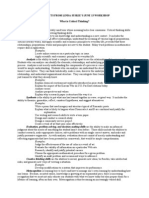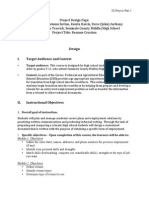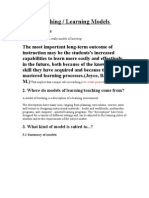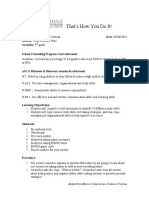Uw Stout Instructional Design Program Overview
Uploaded by
api-309468587Uw Stout Instructional Design Program Overview
Uploaded by
api-309468587UW-Stout Instructional Design Program
Online Course Sequence
Prerequisite: Completion of a bachelor's degree from an accredited institution
Each course is the prerequisite for the next course.
Successful completion with a GPA of 3.0 or higher in each course within the certificate course sequence is
required for registration in the next class.
What is Instructional Design?
Instructional Design (ID) is the systematic approach to determining the need for instruction,
designing and developing objectives, content, and assessments around that need, and
evaluating the effectiveness of your design in relationship to instruction.
Our program models best practices in the field by teaching learners how to design effective
instruction for instructor led or web-based delivery through the alignment of appropriate
instructional strategies and assessments.
This process can be helpful whether you are starting from scratch or redesigning (improving)
existing instruction.
The program also introduces strategies for developing computer-mediated training and matching
technology tools to instructional problems. Finally, students learn skills for managing the
instructional design process whether they are responsible for one project or multiple.
Course 1: EDUC 765 Trends and Issues in Instructional Design
This is an 8-week online instructional design course
which provides an introduction to learning theory,
instructional design models, and the instructional
design and development process. You will study
variables that affect adult learning, techniques for
stimulating and sustaining learner motivation, and
how to reinforce learning.
Whether you are in health care, education, business,
software development or any other industry, this
online course will help you to analyze, design, and
develop instruction.
NOTE: Throughout the instructional design
certificate courses you will create portfolio quality
products. For this course, you will create a course
design document and develop a unit or module of
instruction.
Learning Outcomes
Upon completion of the instructional design course,
students will be able to:
1.
2.
3.
4.
5.
6.
7.
Analyze processes of designing instruction and
summarize the components of instructional
design models.
Compare and analyze several models for
instructional design.
Apply motivation theory to the instructional
design process.
Apply and summarize adult learning theories.
Compare learning theories and create a learning
philosophy.
Research and analyze components needed to
conduct a front-end analysis for an instructional
product and explain variables linked to cultural
and linguistic diversity.
Apply research-based design model(s) to an
instructional problem.
Course 2: EDUC 766 Instructional Strategies and Assessment Methods
What You Will Learn
Course Description: Development of instructional goals, objectives and assessment of outcomes. Methods for
assessing learner performance and mapping appropriate assessment methods to instructional strategies and
learning objectives. Performance-based assessment and tools to assess learner performance. Design of formative
and summative methods.
Learning Outcomes
Upon completion of the course, students will be able to:
1.
2.
3.
4.
5.
6.
Design well-defined instructional goals and learning objectives for all three domains.
Evaluate and select instructional strategies based on front-end analysis which includes a focus on providing
equitable access to digital tools and resources for culturally and linguistically diverse learners.
Align appropriate instructional strategies with learning objectives.
Evaluate a variety of assessment methods for learning including authentic assessments, self and peer
evaluation, rubrics, online surveys, e-portfolios, tests and mini-quizzes for self-paced tutorials.
Demonstrate research-based practices for choosing assessment models and align assessment methods with
instructional strategies, objectives, and learning outcomes and justify selected assessment choice.
Develop tools to evaluate instruction using formative and summative assessment methods.
Course objectives are aligned with the following
teaching standards:
Wisconsin Standards for Teacher Development and
Licensure (WI DPI): # 4, 7, 8
International Society for Technology in Education,
National Educational Technology Standards (NETS-T)
#2a, 2b, 2c, 2d
National Board Teaching Standards:
Use effective communication techniques, media and
technology to foster active inquiry, collaboration
and supportive interaction in the classroom.
Use instructional technology to enhance student
learning.
Use formal and informal assessment strategies to
evaluate student progress.
Course Concepts
1.
2.
3.
4.
5.
How objectives, instructional strategies, and assessment are linked. The critical nature of triangulation.
The importance of sequencing material at the various levels of instructional objectives, lessons, and topics.
Instructional strategies: when and how to include activities for direct instruction, practice, and transfer of
learning. Examples include narrated PowerPoint, video, podcasts, and screencasts, drill and practice, case
studies, self-assessments, games, and simulations.
Assessing learning: methods for traditional and alternative assessments, including authentic assessments, self
and peer evaluation, rubrics, online surveys, e-portfolios, tests and mini-quizzes for self-paced tutorials. The
role of feedback in learning.
How assessment informs evaluation. Appropriate use of formative and summative data for decision-making
and future development.
Course 3: EDUC 767 Designing Computer-Based Training (CBT)
What Will You Learn
Course Description: Just-in-time scenario-based modular development, user interface design, visual design,
usability testing, and execution of common instructional strategies employed in self-paced products. Research,
trends and standards in computer-based training; development of reusable learning objects using multimedia
software.
Software Options
Learning Outcomes
This course focuses on the design of CBT relevant to
your working environment. For your final portfolio
project, you will create a SCORM compliant reusable
learning object using multimedia software. You may
use a free web-based starter tool, Udutu. A tutorial
and a complete User's Guide in PDF format are
provided on the website.
Upon completion of the course, students will be
able to:
You will also research and discuss industry leading
software. You may use Adobe Captivate, Articulate
Storyline or Studio, or SoftChalk authoring tools if
you are familiar with the software or your
organization currently uses the software.
Educational pricing is available for students who
purchase software directly from the company.
1.
2.
3.
4.
5.
6.
7.
8.
Apply the systematic process of instructional
design to develop a Sharable Content Object
Reference Model (SCORM) compliant reusable
learning object.
Compare and contrast varying instructional
strategies for Computer-Based Training (CBT)
and select the appropriate strategy for the
learning requirements.
Apply principles of interface design and usability
testing and address cultural needs and diversity
in CBT design.
Summarize advantages and disadvantages of
designing instruction for reusability.
Apply the components and instructional
theories of well-designed CBT when creating
self-paced learning products.
Articulate factors involved with designing,
developing, and implementing assessments in
CBT.
Organize and sequence content for tutorials by
flowcharting a branching scenario for
remediation.
Analyze how to repurpose content for different
audiences, contexts, and delivery media.
Course 4: EDUC 768 Project Management for Instructional Development
What Will You Learn
Course Description: Examination of the initiation, planning, and closure of instructional development
projects and practical knowledge on managing project scope, work breakdown structure, schedules, and
resources including budgeting. Analysis of instructional development project life cycle.
This course replicates projects in the "real world," and you will complete all work in teams. Your peers will
depend on you for timely feedback as you interact via email and the discussion board during team and
small work groups to complete assigned tasks. Therefore, students need to login and participate with
their group several times each week.
Learning Outcomes
Upon completion of the course, students will be
able to:
1. Break down the project management
process and relate it to the instructional
development process.
2. Demonstrate an understanding of and
application of components of the initiation
phase by producing deliverables for the
phase.
3. Assess the value of a Work Breakdown
Structure (WBS) and create a WBS.
4. Develop detailed schedules for instructional
development projects.
5. Select and organize resources necessary for
successful project completion.
6. Plan and apply the steps in project closure.
7. Adapt project management and instructional
design principles to scale single projects to
multi-course production models.
Course objectives are aligned with the
following standards:
Wisconsin Standards for Teacher Development
and Licensure (WI DPI): # 4
International Society for Technology in
Education, National Educational Technology
Standards (NETS-T) # 3a, 5b
Because this class is asynchronous and open to
you 24/7, you may participate from your home
or work computer during hours that are best for
your work and family schedule.
The class is highly interactive with a significant
discussion component. All projects/assignments
will be submitted via the course Dropbox and
discussion board.
http://www.uwstout.edu/soe/profdev/instructionaldesigncert.cfm
You might also like
- Download slideology The Art and Science of Creating Great Presentations ebook All Chapters PDF100% (2)Download slideology The Art and Science of Creating Great Presentations ebook All Chapters PDF24 pages
- 7490 Assignment 7 Research On Visual and Media Literacy Final MDG PDFNo ratings yet7490 Assignment 7 Research On Visual and Media Literacy Final MDG PDF9 pages
- Creating Communities of Practice by Charlotte DanielsonNo ratings yetCreating Communities of Practice by Charlotte Danielson7 pages
- The June Maker Model For GT Curriculum Differentiation: Learning EnvironmentNo ratings yetThe June Maker Model For GT Curriculum Differentiation: Learning Environment2 pages
- Lesson Planning Form For Accessible Instruction - Calvin College Education ProgramNo ratings yetLesson Planning Form For Accessible Instruction - Calvin College Education Program3 pages
- Unit 1: Preliminary Concepts and Recent Trends: Assessment in Learning 1100% (1)Unit 1: Preliminary Concepts and Recent Trends: Assessment in Learning 135 pages
- Dick and Carey Instructional Model - Educational TechnologyNo ratings yetDick and Carey Instructional Model - Educational Technology5 pages
- Reconciling ADDIE and Agile Instructional Design MNo ratings yetReconciling ADDIE and Agile Instructional Design M9 pages
- Is There A Successful Id Model?: A Practitioner'S Perspective On Working With Models in Designing Elearning EnvironmentsNo ratings yetIs There A Successful Id Model?: A Practitioner'S Perspective On Working With Models in Designing Elearning Environments27 pages
- Instructional Design in Teaching Basic Electrical Engineering UsingNo ratings yetInstructional Design in Teaching Basic Electrical Engineering Using6 pages
- Adamsdupuisjezequel Idprojectpart1 7464-4No ratings yetAdamsdupuisjezequel Idprojectpart1 7464-46 pages
- Addie Model: The Is A Five-Phase Approach To Building Effective Learning SolutionsNo ratings yetAddie Model: The Is A Five-Phase Approach To Building Effective Learning Solutions1 page
- Uncertainty in Teacher Education Futures: Sandy Schuck Peter Aubusson Kevin Burden Sue BrindleyNo ratings yetUncertainty in Teacher Education Futures: Sandy Schuck Peter Aubusson Kevin Burden Sue Brindley271 pages
- 2003 - Design-Based Research An Emerging Paradigm For Educational Inquiry PDFNo ratings yet2003 - Design-Based Research An Emerging Paradigm For Educational Inquiry PDF4 pages
- 2015 - Clarke Et Al - Dialogic InstructionNo ratings yet2015 - Clarke Et Al - Dialogic Instruction12 pages
- 2 Instructional Design Theories and Models_ An Overview of Their Current StatusNo ratings yet2 Instructional Design Theories and Models_ An Overview of Their Current Status34 pages
- Gustafson and Branch Survey of Instructional Development Models 4th Edition PDFNo ratings yetGustafson and Branch Survey of Instructional Development Models 4th Edition PDF93 pages
- Universal Design For Learning and Differentiated Instruction in Physical EducationNo ratings yetUniversal Design For Learning and Differentiated Instruction in Physical Education20 pages
- ePortfolio Performance Support Systems: Constructing, Presenting, and Assessing PortfoliosFrom EverandePortfolio Performance Support Systems: Constructing, Presenting, and Assessing PortfoliosNo ratings yet
- Caring to Teach, Teaching to Care: The Importance of Relationship, Respect, Responsibility, Relevance, and Rigor in the ClassroomFrom EverandCaring to Teach, Teaching to Care: The Importance of Relationship, Respect, Responsibility, Relevance, and Rigor in the ClassroomNo ratings yet
- A Practical Guide to a Task-based Curriculum: Planning, Grammar Teaching and AssessmentFrom EverandA Practical Guide to a Task-based Curriculum: Planning, Grammar Teaching and AssessmentNo ratings yet
- Intelligent and Effective Learning Based on the Model for Systematic Concept TeachingFrom EverandIntelligent and Effective Learning Based on the Model for Systematic Concept Teaching5/5 (1)
- Multicultural Education Training: The Key to Effectively Training Our TeachersFrom EverandMulticultural Education Training: The Key to Effectively Training Our TeachersNo ratings yet
- Training Needs Analysis With Customers and The Participants100% (1)Training Needs Analysis With Customers and The Participants5 pages
- Meditation With Yoga, Group Therapy With Hypnosis, and Psychoeducation For Long-Term Depressed Mood: A Randomized Pilot TrialNo ratings yetMeditation With Yoga, Group Therapy With Hypnosis, and Psychoeducation For Long-Term Depressed Mood: A Randomized Pilot Trial16 pages
- Depression Anxiety Stress Scales DASS3481 Survey QuestionnaireNo ratings yetDepression Anxiety Stress Scales DASS3481 Survey Questionnaire1 page
- Self-Esteem Worksheet - 09 - Adjusting Rules and AssumptionsNo ratings yetSelf-Esteem Worksheet - 09 - Adjusting Rules and Assumptions1 page
- My Mother Tongue: The Language I First Learned100% (1)My Mother Tongue: The Language I First Learned16 pages
- Practicum Self Assessment - Heidi WippelNo ratings yetPracticum Self Assessment - Heidi Wippel4 pages
- Our Classroom!: Miss Gismondi's 2nd / 3rd Grade Class - LiteracyNo ratings yetOur Classroom!: Miss Gismondi's 2nd / 3rd Grade Class - Literacy1 page
- Family Assessment and Intervention For High Risk GroupNo ratings yetFamily Assessment and Intervention For High Risk Group14 pages
- Organizational Citizenship Behavior (Dennis Organ, 2009)No ratings yetOrganizational Citizenship Behavior (Dennis Organ, 2009)15 pages
- Department of Education: Portfolio AssessmentNo ratings yetDepartment of Education: Portfolio Assessment17 pages
- Download slideology The Art and Science of Creating Great Presentations ebook All Chapters PDFDownload slideology The Art and Science of Creating Great Presentations ebook All Chapters PDF
- 7490 Assignment 7 Research On Visual and Media Literacy Final MDG PDF7490 Assignment 7 Research On Visual and Media Literacy Final MDG PDF
- Creating Communities of Practice by Charlotte DanielsonCreating Communities of Practice by Charlotte Danielson
- The June Maker Model For GT Curriculum Differentiation: Learning EnvironmentThe June Maker Model For GT Curriculum Differentiation: Learning Environment
- Lesson Planning Form For Accessible Instruction - Calvin College Education ProgramLesson Planning Form For Accessible Instruction - Calvin College Education Program
- Unit 1: Preliminary Concepts and Recent Trends: Assessment in Learning 1Unit 1: Preliminary Concepts and Recent Trends: Assessment in Learning 1
- Dick and Carey Instructional Model - Educational TechnologyDick and Carey Instructional Model - Educational Technology
- Reconciling ADDIE and Agile Instructional Design MReconciling ADDIE and Agile Instructional Design M
- Is There A Successful Id Model?: A Practitioner'S Perspective On Working With Models in Designing Elearning EnvironmentsIs There A Successful Id Model?: A Practitioner'S Perspective On Working With Models in Designing Elearning Environments
- Instructional Design in Teaching Basic Electrical Engineering UsingInstructional Design in Teaching Basic Electrical Engineering Using
- Addie Model: The Is A Five-Phase Approach To Building Effective Learning SolutionsAddie Model: The Is A Five-Phase Approach To Building Effective Learning Solutions
- Uncertainty in Teacher Education Futures: Sandy Schuck Peter Aubusson Kevin Burden Sue BrindleyUncertainty in Teacher Education Futures: Sandy Schuck Peter Aubusson Kevin Burden Sue Brindley
- 2003 - Design-Based Research An Emerging Paradigm For Educational Inquiry PDF2003 - Design-Based Research An Emerging Paradigm For Educational Inquiry PDF
- 2 Instructional Design Theories and Models_ An Overview of Their Current Status2 Instructional Design Theories and Models_ An Overview of Their Current Status
- Gustafson and Branch Survey of Instructional Development Models 4th Edition PDFGustafson and Branch Survey of Instructional Development Models 4th Edition PDF
- Universal Design For Learning and Differentiated Instruction in Physical EducationUniversal Design For Learning and Differentiated Instruction in Physical Education
- ePortfolio Performance Support Systems: Constructing, Presenting, and Assessing PortfoliosFrom EverandePortfolio Performance Support Systems: Constructing, Presenting, and Assessing Portfolios
- Caring to Teach, Teaching to Care: The Importance of Relationship, Respect, Responsibility, Relevance, and Rigor in the ClassroomFrom EverandCaring to Teach, Teaching to Care: The Importance of Relationship, Respect, Responsibility, Relevance, and Rigor in the Classroom
- A Practical Guide to a Task-based Curriculum: Planning, Grammar Teaching and AssessmentFrom EverandA Practical Guide to a Task-based Curriculum: Planning, Grammar Teaching and Assessment
- Intelligent and Effective Learning Based on the Model for Systematic Concept TeachingFrom EverandIntelligent and Effective Learning Based on the Model for Systematic Concept Teaching
- Multicultural Education Training: The Key to Effectively Training Our TeachersFrom EverandMulticultural Education Training: The Key to Effectively Training Our Teachers
- Training Needs Analysis With Customers and The ParticipantsTraining Needs Analysis With Customers and The Participants
- Meditation With Yoga, Group Therapy With Hypnosis, and Psychoeducation For Long-Term Depressed Mood: A Randomized Pilot TrialMeditation With Yoga, Group Therapy With Hypnosis, and Psychoeducation For Long-Term Depressed Mood: A Randomized Pilot Trial
- Depression Anxiety Stress Scales DASS3481 Survey QuestionnaireDepression Anxiety Stress Scales DASS3481 Survey Questionnaire
- Self-Esteem Worksheet - 09 - Adjusting Rules and AssumptionsSelf-Esteem Worksheet - 09 - Adjusting Rules and Assumptions
- Our Classroom!: Miss Gismondi's 2nd / 3rd Grade Class - LiteracyOur Classroom!: Miss Gismondi's 2nd / 3rd Grade Class - Literacy
- Family Assessment and Intervention For High Risk GroupFamily Assessment and Intervention For High Risk Group
- Organizational Citizenship Behavior (Dennis Organ, 2009)Organizational Citizenship Behavior (Dennis Organ, 2009)

























































































